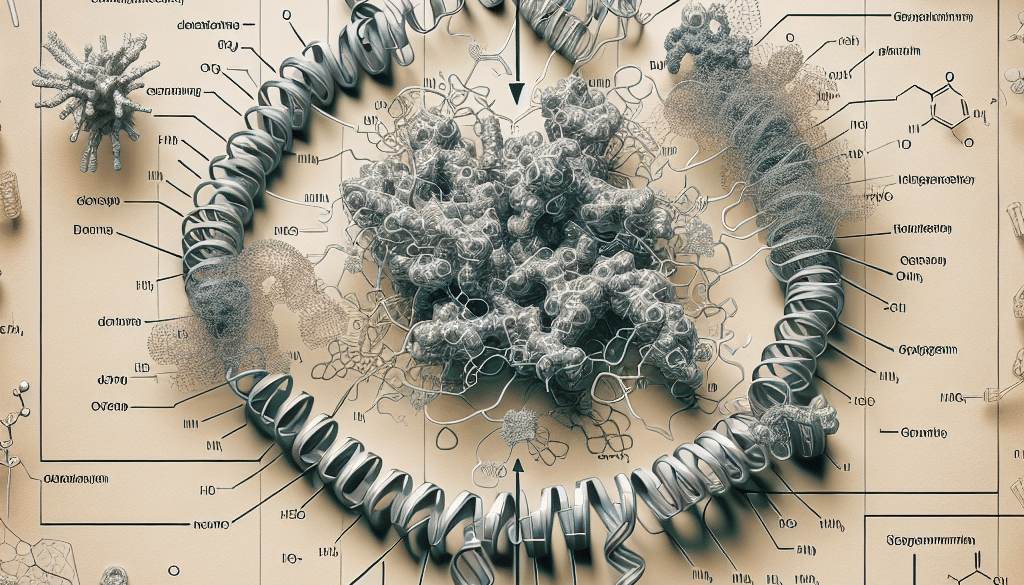Arrow D Is Indicating a Protein: Deciphering Diagrams in Biology
-
Table of Contents
- Deciphering Biology Diagrams: Understanding Protein Indicators
- The Role of Proteins in Biological Diagrams
- Interpreting Arrow Indicators in Diagrams
- Case Studies: Real-World Examples
- Statistics and Their Importance
- Best Practices for Deciphering Diagrams
- Conclusion: Key Takeaways for Understanding Protein Indicators
- Discover ETprotein’s High-Quality Protein Products
Deciphering Biology Diagrams: Understanding Protein Indicators

Biology, the study of life and living organisms, is a complex field that often relies on diagrams to illustrate structures, processes, and functions. One common feature in biological diagrams is the use of arrows and labels to indicate specific components, such as proteins. Understanding how to interpret these diagrams is crucial for students, researchers, and professionals in the field of biology. This article will delve into the significance of arrow indicators in biological diagrams, particularly when they point to proteins, and how to accurately interpret these visual aids.
The Role of Proteins in Biological Diagrams
Proteins are fundamental to all biological processes. They serve as enzymes, structural components, signaling molecules, and transporters, among other functions. In biological diagrams, proteins are often represented by shapes such as ovals or rectangles, with arrows (e.g., “Arrow D”) pointing to them to indicate their role or the direction of a process.
Interpreting Arrow Indicators in Diagrams
When an arrow points to a protein in a diagram, it typically signifies one of several possibilities:
- Input or Substrate: The arrow may indicate a molecule that is entering a reaction or being processed by the protein.
- Direction of Action: It can show the direction in which the protein is exerting its effect, such as the path of a signaling cascade.
- Product Release: An arrow leading away from a protein might represent the release of a product following a reaction.
- Activation or Inhibition: Arrows can also denote the activation or inhibition of a protein by another molecule.
Understanding the context and the specific conventions of the diagram is essential for accurate interpretation.
Case Studies: Real-World Examples
Let’s explore some real-world examples where understanding arrow indicators in biological diagrams is crucial:
- Metabolic Pathways: In diagrams of metabolic pathways, arrows show the flow of metabolites through various enzymatic reactions, with each enzyme being a protein that facilitates a specific step.
- Signal Transduction Pathways: These diagrams illustrate how signals are transmitted within and between cells. Arrows indicate the direction of signal flow and the involvement of proteins such as receptors and kinases.
- Immunological Responses: Diagrams depicting immune responses often use arrows to show the interaction between antigens and antibodies, where the antibodies are proteins that recognize and bind to foreign substances.
Each of these examples highlights the importance of accurately interpreting arrow indicators to understand the biological processes being depicted.
Statistics and Their Importance
Statistical data can provide insights into the prevalence of certain proteins and their roles in various diseases or biological functions. For instance, research has shown that certain proteins, indicated by arrows in diagrams, are overexpressed in specific types of cancer, making them targets for drug development. Understanding these diagrams can therefore have significant implications for medical research and treatment strategies.
Best Practices for Deciphering Diagrams
To effectively interpret biological diagrams, consider the following best practices:
- Study the Legend: Always review the legend or key to understand the symbols and conventions used in the diagram.
- Contextualize the Information: Consider the broader context of the diagram, such as the type of biological process or system being represented.
- Follow the Flow: Trace the arrows from start to finish to understand the sequence of events or reactions.
- Review Related Literature: Consult scientific literature for detailed explanations of the processes depicted in the diagram.
By applying these practices, readers can enhance their comprehension of complex biological diagrams and the roles of proteins within them.
Conclusion: Key Takeaways for Understanding Protein Indicators
In conclusion, arrow indicators in biological diagrams serve as essential guides to understanding the roles and interactions of proteins in various biological processes. Accurate interpretation of these diagrams is crucial for students, researchers, and professionals in biology-related fields. By recognizing the significance of arrow directions, familiarizing oneself with diagram conventions, and contextualizing the information presented, one can gain valuable insights into the intricate workings of life at the molecular level.
Discover ETprotein’s High-Quality Protein Products
If you’re in the market for premium protein products, consider ETprotein’s offerings. Their extensive range of plant-based proteins, including organic rice protein, pea protein, and various seed proteins, caters to a wide array of industries. With a focus on non-GMO, allergen-free products, ETprotein is a trusted supplier for businesses seeking high-quality, sustainable protein solutions.
About ETprotein:
ETprotein, a reputable plant protein vegan protein Chinese factory manufacturer and supplier, is renowned for producing, stocking, exporting, and delivering the highest quality organic bulk vegan protein and plant proteins. They include Organic rice protein, clear rice protein, pea protein, clear pea protein, watermelon seed protein, pumpkin seed protein, sunflower seed protein, mung bean protein, peanut protein etc. Their offerings, characterized by a neutral taste, non-GMO, allergen-free attributes, cater to a diverse range of industries. They serve nutraceutical, pharmaceutical, cosmeceutical, veterinary, as well as food and beverage finished product distributors, traders, and manufacturers across Europe, USA, Canada, Australia, Thailand, Japan, Korea, Brazil, and Chile, among others.
ETprotein specialization includes exporting and delivering tailor-made protein powder and finished nutritional supplements. Their extensive product range covers sectors like Food and Beverage, Sports Nutrition, Weight Management, Dietary Supplements, Health and Wellness Products, and Infant Formula, ensuring comprehensive solutions to meet all your protein needs.
As a trusted company by leading global food and beverage brands and Fortune 500 companies, ETprotein reinforces China’s reputation in the global arena. For more information or to sample their products, please contact them and email sales(at)ETprotein.com today.












